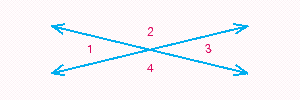When two lines intersect as in the illustration below, four angles are formed. Angles that are side-by-side, such as and , are called adjacent angles. Angles that are nonadjacent, such as and or and , are called vertical angles. From geometry, we know that if two lines intersect, vertical angles have the same measure. If and , find x . Read as "the measure of ". 
Definitions:
Q1: Evaluate the expression. <span class="ql-formula"
Q22: Pressing [Ctrl][;] will insert the current date
Q28: A style consists of various formats such
Q34: It takes a grounds keeper 45
Q44: Use the substitution method to solve
Q47: What is the difference between Rich Text
Q62: Simplify the expression by using the
Q64: Graph the linear equation. <span
Q91: Determine which of the ordered pairs
Q97: Find the value of the expression